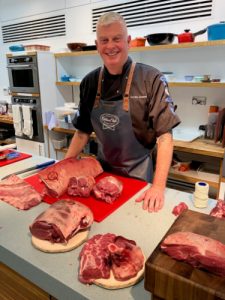Beyond The Chop: A Slow Food Jolly
There are many good reasons to be a member of Slow Food Scotland. This was one of them.

Gordon Newlands
A Wednesday in May found a couple of dozen souls in the premises of the New Town Cookery School in Edinburgh's Queen Street. The food smells were incredible - of that more later. On the counter there was half a lamb carcasse and behind it, a veritable fount of knowledge in the form of Gordon Newlands, butcher extraordinaire.
Gordon is Brands Development Manager with Quality Meat Scotland. He provides support to butchers and Beef Club members in Scotland as well as having regular contact with processors to aid the export market. More importantly he is a butcher with over 30 years' experience and simply knows everything there is to know about butchery.
The purpose of the evening was to learn more about lamb, in particular about use of the lesser known cuts. As the beast was being expertly dissected, Gordon provided a running commentary with all sorts of fascinating facts. Do you know, for example, the difference between Scotch and Scottish lamb? The answer is that to qualify as Scotch lamb, it must be born, reared and slaughtered in Scotland. Today there are 24 abattoirs (though Gordon prefers the word processors) in Scotland. This compares to 41 two decades ago, yet another strain on farmers as increased travel results in additional costs.
On the subject of cost, Gordon expressed cynicism about the likely benefits of a US trade deal to meat exporters in Scotland. Although our food standards here are as high as, if not higher than, those of the US, that won't be enough. Any abattoir involved in the export process to the US will have to be assessed for a number of months by a team of American inspectors - at a cost of £60,000 a week!
If you've ever gone shopping in a proper butcher's shop in England or elsewhere, you'll be aware of the problems with terminology. Take beef for example. Round steak is very popular here. Ask for that down south and you'll get a blank look. There it can equate to topside, silverside or rump. Similar issues arise with lamb. Jacob's Ladder here will translate elsewhere as short ribs. I had never known which was the cut known as breast of lamb. Here, we know it as flank. It's the thin piece of flesh from the underside of the ribs and belly area, requiring a long slow cook.
That's precisely what the lovely Sorina had done, one of the causes of the glorious aromas which permeated the whole room. After Gordon's tour de force, we feasted. Lamb shanks had been slow braised, the meat then being used for wonderful pies. As well as the flank there was also a shoulder. Each one was a dish of wonder: each one absolutely appropriate for a Slow Food meeting.

Sorina, Gordon & Lucia
There was also an array of side dishes created by Sorina and the equally lovely Lucia from Sicily. Some flat breads and some puddings made of bere meal, the latter a recipe from Wendy Barrie's Meadows book. There was wild garlic pesto, tomato and mint salsa, potato and asparagus salad and much more. A terrific way to spend an evening: fascinating people, great food and a ton of information.
A few years ago I featured Slow Food Scotland. Click that link for the article. To go to their website and find out how to join, click here. Happy slow cooking.

I've also written a few times about the very lovely and highly talented Wendy Barrie. Follow the links to find out more about her and her remarkable book Meadows here
Years ago when I lived near Colchester I had many laughs with the local butcher over the Scottish/English terminology of meat. The first time I shopped there and asked for the labelled Scotch beef he asked if it was for a special treat. Don’t know if our beef is still sold at a premium in England.